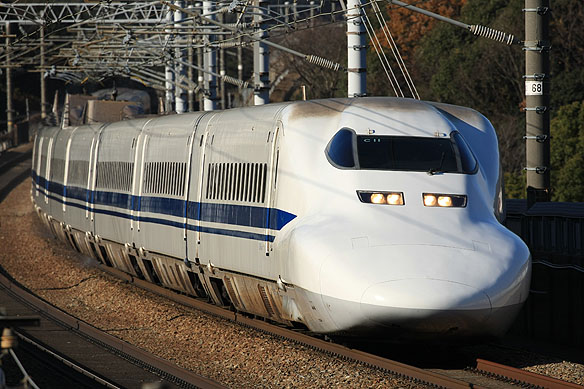700 series designed by JR Central and JR West are the next generation of
Shinkansen vehicles, instead of high-performance and high-cost 500 series
or lower-performance 300 series, introducing the several new technologies
established by 500 series or 300X experimental trains. 700 series entered
service in 1999.
700 series adopt 3M-1T unit to realize 285km/h operation on the Sanyo Shinkansen. AC traction motored rated at 275kW were driven by 3-step IGBT (Insulated Gate Bipolar Transistor) inverter traction system. IGBT inverter traction system ensures lower magnetostrictive noise than 300 series vehicles. Motored vehicles incorporate an AC regenerative braking system, while trailer vehicles employ eddy current braking. 2 single-arm current collectors and fairings are fitted to reduce environmental noise and air resistance.
The double-skin aluminum construction incorporated into the vehicle design
for light weight achieves both silent cabin room and lower cost. The 9.2m
long nose sections are employed to reduce the noise. In order to ensure
smooth ride characteristics even at 285km/h, bolster-less bogies based
on those of 300 series vehicles feature semi-active dumpers and non-linear
air suspensions fitted at wider interval. Anti-yaw dampers are also fitted
between cars for improved stability.
Interior layout and accommodation is very similar to that of 300 series
in the standard layout of 2+2 seating in first class, and 2+3 in standard
class. Seat pitch is same as on the 300 series vehicles with 1040mm in
standard class and 1160mm in first class. The refreshment counters of the
300 and 500 series have been discontinued, and are replaced instead by
vending machines selling drinks. Vehicles introduced from 2001 incorporate
minor interior design improvements, including power outlets for PC users
and hand-grabs on the edge of aisle seats.
700 series entered Tokyo to Hakata NOZOMI services, displacing the 300 series trains used on these trains from 1999. Then 300 series trains used on other NOZOMI and HIKARI services were displaced with 700 series. When increased NOZOMI services started in 2003, 700 series were used on most of NOZOMI services.
8 sets of 700-0 series (C11 to C18) owned by JR Central were transferred
to JR West to replace its fleet of nine 300-3000 series. 700-0 series transferred
to JR West differ from those owned by JR Central in having blue JR logos
and JR West standard onboard alert. 700-0 series have gradually been displaced
by N700-0 series trains. The last remaining Nozomi services using 700 series
were switched to N700 series from 2012, excepting seasonal Nozomi services.
Withdrawals of 700 series sets began in 2012 with the withdrawal of set
C4.
Now 700-0 series are primarily used on Hikari services between Shin-Osaka
and Hakata, and Kodama services between Tokyo and Shin-Osaka. |
|
| Technical Data |
| Items |
Data |
| Built |
1997- |
| Construction |
Aluminum |
| Formation |
12M-4T |
| Supply
voltage |
25,000VAC,
60Hz |
| Service
speed, etc. |
Acceleration:
1.96km/h/s Service speed: 285km/h |
| Length |
27,350mm
(End cars) 25,000mm (Intermediate cars) |
| Width |
3,380mm |
| Height |
3,650mm |
| Bogie |
TDT204
(motored) TTR7002 (trailer) |
| Collector |
TPS301
Single arm (2 per 16-car train) |
| Traction
motor |
T-MT6A,
T-MT7A (275kW) |
| Gear
ratio |
2.96 |
| Controller |
TCI2A
(IGBT) |
| Air
conditioner |
TAU32A |
| Designed
by |
JR
Central |
|
|

